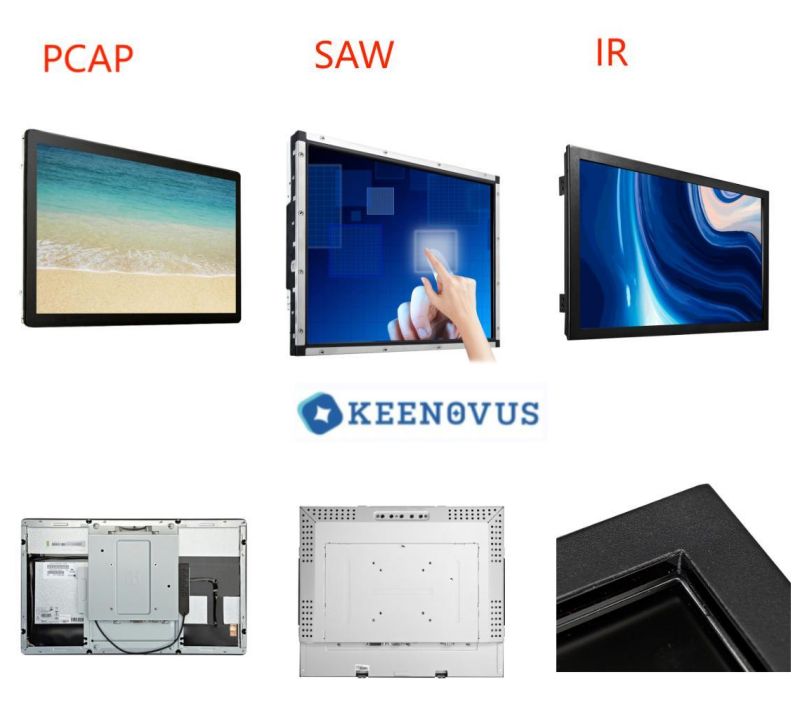Touch screens have become a part of our everyday lives, allowing us to interact with electronic devices in a whole new way. In this article, we’ll explore three types of touch screen technologies: PCAP Touch Screen Technology, IR Infrared Technology, and SAW Technology. Let’s find out how they work and where they can be used.
PCAP touch screen Technology
Pcap Touch Screen Technology represents a more recent iteration of the widely employed capacitive touch sensors. By integrating the identical grid-patterned electrode design found in conventional capacitive sensors, a touch screen with exceptional resolution, rapid response, and intuitive sensitivity is achieved, capable of functioning seamlessly even when covered with laminated glass. The PCAP touch monitor encompasses a variety of PCAP touch technologies, including our Interactive Touch Foil, which has the ability to convert any glass or acrylic surface into a touch screen (and can even detect touch input while wearing gloves). This feature makes it ideal for utilization in store window displays, serving as a prime illustration of the practical application of PCAP touch screen technology. PCAP solutions are offered in single, dual, and multi-touch variations, supporting up to 40 touch points.
IR INFRARED TECHNOLOGY
Infrared touch screens function in a fundamentally distinct manner from any variant of PCAP touch screen technology. An assemblage of LED and infrared photosensors is positioned in a grid configuration along the bezels of an infrared screen, perceiving even the most minute interference in the light beams emitted to establish a point of contact. As these beams are projected in a densely packed grid pattern, infrared screens provide users with swift response times and exceptional tracking capabilities.
Our repertoire encompasses an assortment of infrared display technologies, including our intouch Interactive Touch Screen Overlay kits, which facilitate the transformation of any screen or surface into an interactive display. These overlay kits are compatible with LCD, LED, or Projection displays, enabling the creation of entirely new touch display installations or the seamless integration of touch functionality into existing screens, tables, or video walls, with minimal or no disruption. Our Infrared solutions cater to a broad spectrum of applications and are available in single, dual, and multi-touch configurations, supporting up to 32 touch points.
Saw technology
Surface Acoustic Wave (SAW) is a relatively new type of touchscreen technology that, in recent years, has become increasingly popular. What is a SAW touchscreen exactly?
A SAW touchscreen represents a type of touchscreen device that employs ultrasonic sound waves to detect touch commands. Similar to all touchscreens, they incorporate a digital display interface responsible for generating images and supporting touch commands. To interact with a SAW touchscreen, one simply needs to press or tap their fingers on the display interface.
SAW touchscreens diverge from PCAP touch screen technology in terms of their touch command detection methodology. Unlike other touchscreen devices, SAW touchscreens utilize ultrasonic sound waves to perceive touch commands. These touchscreens are constructed with reflectors and transducers positioned along the edges. The transducers emit ultrasonic sound waves that subsequently bounce off the corresponding reflectors.
When a touch command is executed, the ultrasonic sound waves traversing the surface of the SAW touchscreen encounter disruption caused by the user’s finger. This interruption in the sound wave’s amplitude is detected by the SAW touchscreen’s controller, which proceeds to register it as a touch command.
In conclusion, each touch screen technology has its unique way of detecting touch commands. Whether it’s the grid pattern of PCAP, the infrared sensors of IR technology, or the ultrasonic sound waves of SAW, these technologies have revolutionized the way we interact with electronic devices.
Go to Keenovus website, you can find all industrial touch screen , touch monitors in different touch technology that meet your requirement.
Post time: Jan-02-2024





